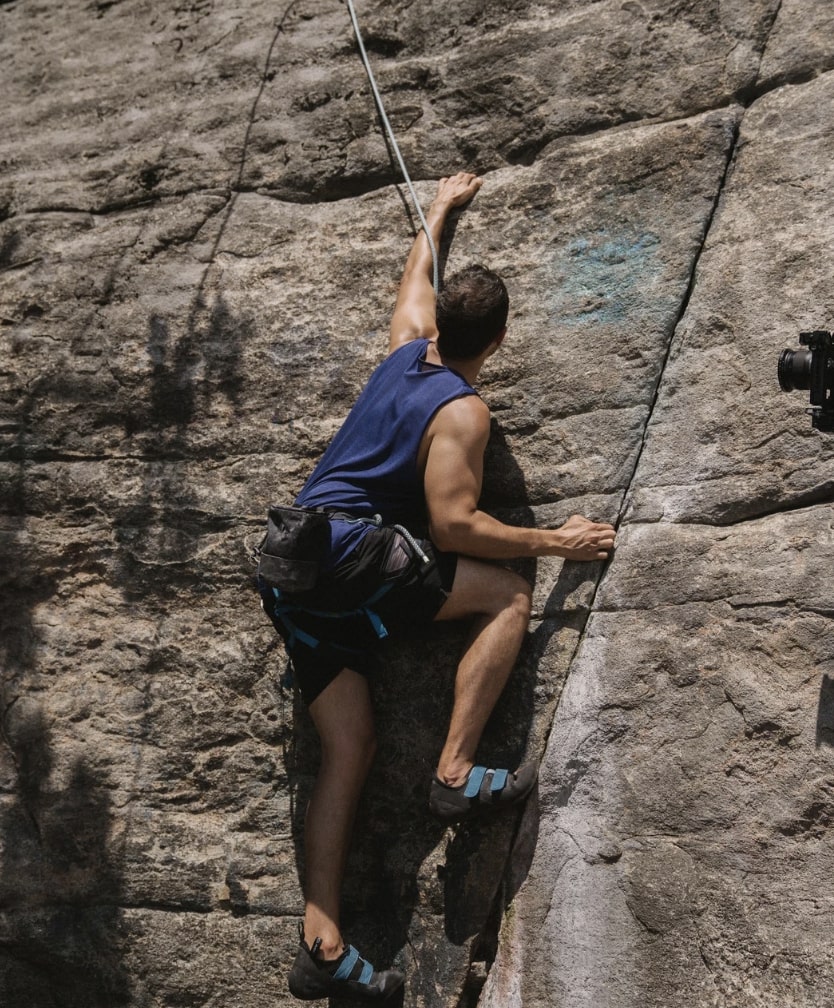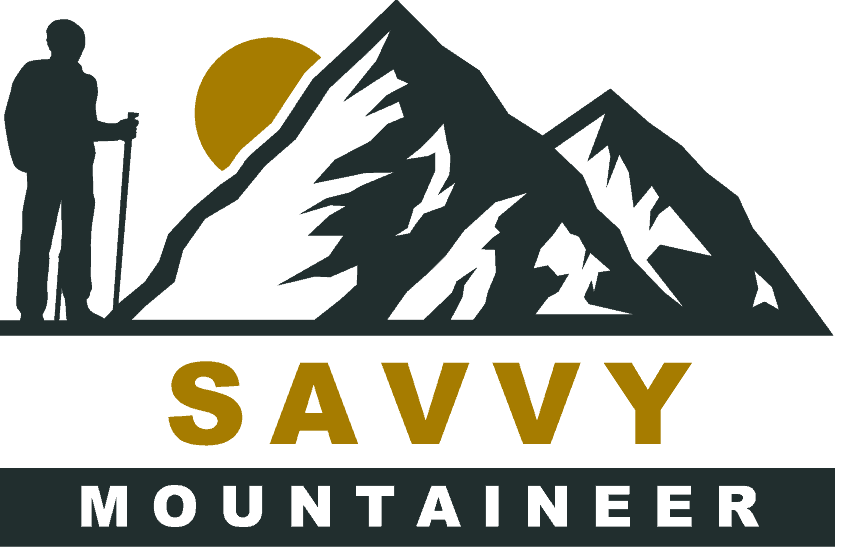Essential Rock Climbing Techniques for Savvy Mountaineers

Mastering rock climbing technique is no easy feat.
In fact, when it’s time to level up and tackle more challenging routes, the number one obstacle climbers face is…
Perfecting their rock climbing technique.
Many lack the necessary knowledge to do so. But this is what separates a novice climber from an expert mountaineer. If you don’t know how to hone your techniques effectively, reaching new heights will always remain elusive.
Climbing efficiently and safely isn’t child’s play, folks.
A case in point: A budding climber recently shared that as soon as he tried implementing advanced moves like ‘Drop Knee’ or ‘Back Step’, he found himself losing balance frequently on steep terrains.
This experience has made him apprehensive about trying out these techniques again. He fears he might never improve his performance or conquer tougher climbs if things continue this way.
Pretty daunting situation!
Understanding Rock Climbing Techniques
In the realm of rock climbing, a multitude of techniques come into play. These methods are essential for not only achieving success in your climbs but also ensuring safety and efficiency.
Back Step Technique
The back step technique involves turning your hip sideways towards the wall and stepping on holds using the outside edge (little-toe side) of your shoe. This method is particularly useful when you’re trying to conserve energy or reach distant holds, especially on steep routes.
To perform this move correctly, it’s crucial that balance is maintained by keeping one foot flat against the surface while twisting your body so that one hip faces the wall. This position allows for increased flexibility and range as you ascend up challenging terrains.
A detailed guide from professional climber Alex Honnold provides further insights into mastering this technique effectively.
Drop Knee Method
An advanced version of the back step known as the drop knee requires rotating the leg inward at a sharp angle, creating tension between the feet which helps hold the body weight off the arms, allowing them to focus more on grip than support. This maneuver demands considerable core strength along with precise foot placement since any slip could lead to loss of stability, causing a potential fall. Hence, it is recommended mainly for experienced climbers who have already mastered basic moves like edging and smearing. If executed properly, though, it offers a great advantage on overhangs where gravity works against climbers, making upward progress challenging.
The Art Of Stemming
In situations where there are two parallel surfaces close enough together, such as corners or wide cracks, ‘stemming’ comes in handy. It involves spreading the legs apart, pushing the feet against opposing walls, generating counter pressure, and helping to stay aloft without much hand support, akin to doing splits vertically. A key aspect here is maintaining straight arms, letting the skeleton take the load rather than the muscles, thereby conserving energy. Another key aspect is shifting weight smoothly from one leg to the other, avoiding sudden jerks that could disrupt balance. The ability to stem efficiently greatly expands the options available during a climb, opening up new possibilities even amidst seemingly difficult terrains. The intricacies involved offer valuable insights for improving stemming skills.
Key Takeaway:
Mastering rock climbing techniques like the back step, drop knee, and stemming can be a game-changer for climbers. These methods not only enhance success in climbs but also ensure safety and efficiency. Remember, it’s all about balance, precise foot placement, core strength and smart energy conservation.
Advanced Moves in Rock Climbing
In the world of rock climbing, it’s not just about reaching the top. It’s also about how you get there and what moves you use to overcome obstacles along your route.
The thrill lies in mastering advanced techniques like flagging, lay-backing, and mantling that can transform a seemingly impossible climb into an achievable challenge. These maneuvers are often employed by elite climbers when they encounter complex terrains or tricky sequences during their ascent.
Flagging Move
If balance is crucial for success on the wall – then Flagging move holds key. This technique involves extending one leg out without placing it on any hold; acting as counterbalance while making upward progress thus helping maintain stability especially during difficult reach-outs.
This isn’t something climbers pick up overnight though; requires consistent practice, body awareness alongside strong core strength. But once mastered, this move has the potential to make even the most challenging climbs seem effortless.
Lay-backing Strategy
A vertical crack might appear daunting initially but with the right strategy at hand, such challenges could be turned into opportunities instead. Laybacking serves exactly this purpose where traditional handholds aren’t available.
Climbers lean back away from the wall using straight arms walking feet upwards creating oppositional force between hands pulling down & feet pushing up thereby enabling smooth ascension despite the lack of obvious footholds. However, remember energy conservation becomes critical here due to reliance on arm strength hence finding quick rests become essential particularly over long routes involving such sections.
Mantle Move
Mantling – name derived from the fireplace mantle because upon successful completion climber should ideally end standing atop hold similar position next to mantel shelf. Think getting out swimming pool edge leveraging upper body power alone – pretty much the same principle applies here too.
Besides physical prowess mental agility plays a significant role since these situations involve overcoming the fear factor associated with committing fully towards pull-up knowing well easy way back down again mayn’t exist anymore therefore practicing safely under supervision initially could prove beneficial until confidence builds naturally through experience.
Key Takeaway:
Rock climbing is more than just reaching the top; it’s about mastering advanced techniques like flagging, lay-backing, and mantling. These moves require practice, body awareness, strong core strength and mental agility to overcome complex terrains or tricky sequences during an ascent.
Utilizing Holds in Rock Climbing

The rock climbing world is full of a range of holds, each providing its own distinct set of difficulties and possibilities. A deep understanding of how to effectively utilize these holds can drastically improve your climbing technique.
Undercling Hold Technique
An undercling hold might initially feel counter-intuitive but it’s an invaluable tool when mastered. This technique involves gripping the hold from underneath and pulling upwards instead of downwards as you would typically do on other types of holds.
To successfully execute an undercling, keep your hips close to the wall maintaining a low center gravity while simultaneously pushing hard with your feet as you pull up with your hands – this drives upward progress efficiently. The execution demands good finger strength and core stability because often enough, climbers find themselves hanging off relatively small footholds whilst balancing their body weight against gravity.
Incorporating specific exercises like fingerboard hangs into training routines will help build necessary strength for mastering this move which opens new possibilities on the climb route ahead.
Side Pull Hold Strategy
A side pull is another type of hold where climber pulls laterally rather than downward or upward direction offering much-needed relief when vertical handholds are scarce or awkwardly positioned along ascent path allowing climbers set strategic body positions using lateral forces against rock face.
The key here lies in creating tension between foot placements and handhold thus facilitating movement towards desired direction. It’s important during execution to maintain straight arms wherever possible helping conserve energy whilst improving reach potential across wall surface without overstraining muscles unnecessarily.
Incorporating dynamic movement practices such as flagging – extending one leg outwards away from body line could also aid in maintaining balance especially if footholds are sparse along route ahead.
Lastly remember every climb presents different combinations so understanding variety applying them accordingly ensures efficient successful ascents no matter what nature throws way.
Key Takeaway:
Rock climbing success hinges on mastering a variety of holds, each with its unique challenges and opportunities. Undercling hold technique requires strength and balance, while side pull strategy relies on tension between foot placements and handhold. Incorporating specific exercises into training routines will enhance these skills.
Specialized Techniques for Specific Situations
Two such strategies are gaston and palming which present new opportunities on the wall by leveraging body position and strength in unconventional ways.
Gaston Maneuver
The Gaston maneuver is a technique named after French climber Gaston Rebuffat who brought it to prominence. It’s all about hand grip where fingers point towards each other as if you’re opening a jar or pushing apart elevator doors with palms facing outwards.
This method can be challenging due its reliance more on upper-body muscle groups than typical gripping skills. But when used correctly, this move allows climbers set their own path against holds instead of pulling down, creating entirely different dynamic aiding upward progress.
To make most out this approach keep elbow approximately same height as your hand; maximizing leverage while reducing strain forearm muscles – vital tip ensuring efficient climbs conserving energy crucial during long ascents. Learn here how endurance plays role successful climbs.
Palming Approach
Different from many moves primarily relying finger strength Palming leverages entire surface one’s palm apply pressure onto features rock face hold surfaces without specific grips available – much like pressing hands against walls inside narrow corridors trying not fall over.
- To execute effectively place palm firmly against rock applying even pressure across whole area;
- Maintain straight arms thus reducing fatigue letting skeleton bear weight;
- Focus footwork use big toe’s inside edge maximizing friction between shoe rubber & rock.
Climbers Set Their Own Path
No two routes identical outdoor climbing making every climb unique requiring own set strategies. While some situations may call common techniques like edging smearing etc., others might necessitate less-commonly-used approaches discussed above i.e., Gastoning & Palming. In essence elite climbers learn multitude styles adapt flexibly according terrain demands thereby continuously improving skillset throughout their climbing career. Read here stories seasoned climbers sharing experiences dealing psychological aspects involved. Thus mastering art mountain ascent isn’t merely building muscular power equally importantly nurturing mental resilience alongside technical proficiency.
Key Takeaway:
Mastering rock climbing isn’t just about physical strength; it’s also about mental resilience and technical proficiency. Unique techniques like the Gaston maneuver and Palming approach can be game-changers, allowing climbers to adapt flexibly according to terrain demands, conserve energy during long ascents, and create their own unique path up the wall.
FAQs in Relation to Rock Climbing Technique
Is there a technique to rock climbing?
Absolutely, rock climbing involves various techniques like back stepping, drop knee method, flagging move, and more. Mastering these techniques can significantly enhance your performance on the wall.
What is the 90 degree rule in climbing?
The 90-degree rule refers to keeping your arms bent at about 90 degrees while resting during climbs. This helps conserve energy by allowing muscles to relax without losing grip.
What is a Gaston?
A Gaston is a specialized climbing maneuver where you press outward against holds instead of pulling down. It’s named after French climber Gaston Rébuffat.
How do I improve my climbing technique?
To improve your climbing technique, practice different moves regularly, work on strength training and flexibility exercises off the wall, and learn from experienced climbers or trainers.
Conclusion
It’s about understanding the basics and then pushing your limits.
The back step, drop knee, stemming – they’re all tools in your mountaineering arsenal.
Moving on to advanced moves like flagging and lay-backing takes you up another notch.
Holds? They’re more than just places to grip; underclings and side pulls can be game-changers when used strategically.
Gaston maneuver or palming approach might seem intimidating at first but remember every expert was once a beginner too!


Deeba & Matt
About the Authors
Intrepid content creators and relentless hiking enthusiasts. With a passion for travel and adventure, Matt & Deeba are never one to shy away from a daring challenge.
